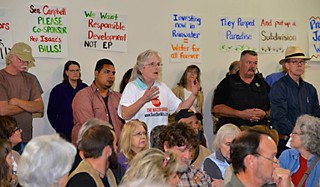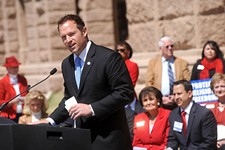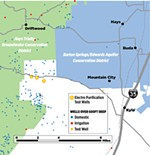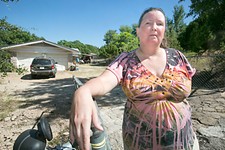Hays County Water War Continues
Lawsuits and legislation address water regulation
By Vicki Wolf, Fri., May 1, 2015
Hays County residents are waiting to see if a lawsuit or legislation will prevent Electro Purification, LLC, from pumping more than 5 million gallons of water a day from a currently unregulated area of the Trinity Aquifer in Hays County. The Houston-based company is contracting to sell the water to Buda and other cities in the sprawling suburbs of Southwest Austin.
The lawsuit, filed by Trinity Edwards Springs Protection Association, argues that the Hays Trinity Groundwater Conservation District should have authority over the area. And HB 3405 – one of the bills Rep. Jason Isaac, R-Dripping Springs, filed with the Texas House of Representatives to regulate the EP project – would give authority to regulate the area to the Barton Springs/Edwards Aquifer Conservation District. (The bill is currently in Calendars Committee, awaiting a committee hearing.)
EP and TESPA have agreed to have the lawsuit heard by the State Office of Administrative Hearings, which manages contested cases for Texas organizations. TESPA also has in place a pending lawsuit to be able to take action if EP starts drilling more wells without a permit during the hearing process.
The Hays Trinity GCD doesn't possess the equivalent resources nor the scientists for oversight that are available to the BSEACD; placing the regulation of this part of the Trinity Aquifer with BSEACD would enable management of the aquifer on a regional basis, and that makes sense, according to John Dupnik, BSEACD general manager. The Trinity Aquifer and the Edwards Aquifer are interconnected with each other and with the creeks and springs of the region – the Trinity, in many places, provides base flow for the creeks. When the creeks flow downstream they cross into the Edwards, and they recharge that aquifer; pumping from the Trinity where it's shallow can impact creek flow and ultimately affect the Edwards. "It's kind of a tricky thing," said Dupnik. "Our nature is to try to carve it up into little jurisdictions and parcel it out in structured ways. But the reality is, it's one connected system, and to the degree you can manage it holistically, that's ideal."
Dupnik explained that BSEACD would not seek to kill the EP project. "We hope to come in as a voice of reason to apply everything that we've learned in our nearly 30 years of managing aquifers, and let the science drive the decisions." Dupnik acknowledged that there's some concern, especially among EP project developers, that BSEACD's assessment of what the aquifer can yield with minimal effect on the wells in the region may not support what the company has already contracted to provide.
Louie Bond, editor of Texas Parks & Wildlife, lives near the EP well field. She said both conservation districts have been very responsive to the needs of citizen organizers. "In this particular situation, we probably have better resources at Barton Springs," she said. "They could work in conjunction with Hays Trinity to protect that whole section of the Trinity Aquifer."
It's been four months since Hays County citizens learned of the EP project and the potential threat to the community's main source of water. Bond said they're getting tired, but they must continue to be vigilant. "The main thing for us is that we have so much at stake, that we have no choice but to continue fighting until something happens," she said. "No less than the future of the Trinity Aquifer depends on it."
Got something to say on the subject? Send a letter to the editor.











